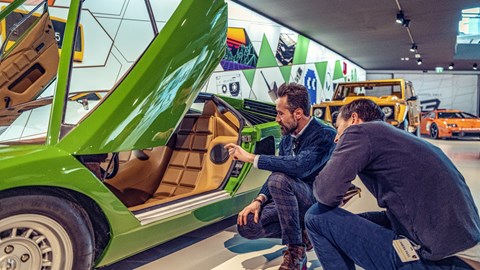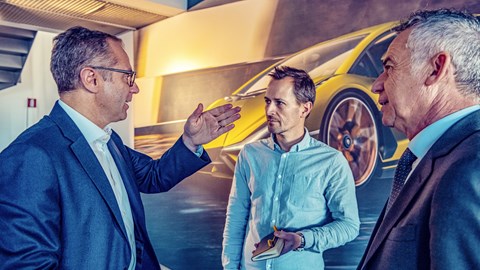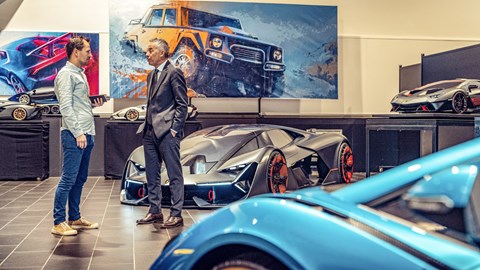► What does the future hold for Lamborghini?
► Chris Chilton chats to chief exec Domenicali
► Legendary supercar brand in fighting shape
The earliest surviving Countach is looking better – and more original – than it has in years. Rescued from a barn in Switzerland in 2000, and brought back to Sant’Agata, chassis #001 has spent the last two decades in Lamborghini’s on-site museum, which links the factory’s modern entrance with the ’60s original.
The museum’s much better for a recent refresh, and so is the car. Originally painted red for its appearance at the 1973 Geneva motor show, it was resprayed green for that autumn’s Paris salon, and has just received another coat of the same. But the big change is beyond those scissor doors.

The original alcantara-covered dash and bizarre blocky seats that look like giant, slightly melted Cadbury’s Dairy Milk bars, which were replaced with regular production items when the car was sold off in the early ’70s, have been replicated with help of photographs from a period magazine. It looks fantastic, though the driving position and overall total lack of comfort is as awful now as it was 14 years ago when I sat in the non-running Countach and made V12 noises to myself. Rooowwwwoooorrrrr!
CAR Archive: Countach vs rivals, 1984
One of the many pressing questions facing chief executive Stefano Domenicali is how Lamborghini can avoid leaving it to future customers to bring their own noise. Will it be possible for Lamborghini, a company whose legend is built partly around glorious howling engines, to transition to the electrified era in a way that’s true to its spirit – in sound, in style and in performance?
The ever-smiling Domenicali seems unfazed. After all, at the time of our meeting, 2020 was on course to be Lamborghini’s best year yet. But that course has changed. As I write this, weeks after our visit, Lamborghini’s Sant’Agata factory lies silent, struck dumb by the Covid-19 virus that ravaged northern Italy. A forced shutdown has temporarily halted production in what was set to be a bumper year.
Emboldened by the introduction of the Urus SUV, Lamborghini’s 2019 sales skyrocketed 43 per cent to an all-time high of 8205 units. That was the ninth consecutive year of global sales growth, built on record-breaking expansion in every region. Although the Urus accounted for nearly 5000 of those sales, both the V10 and V12 sports cars were also selling well. The smaller family, now five years old, became Lamborghini’s all-time best-seller during 2019; the Huracan’s predecessor, the Gallardo, took twice as long to sell the same 14,000 units.

The Sant’Agata site that occupied 10,000 square metres back in 1963 takes up 160,000 today. The workforce has swollen hugely, too. In 2011 there were fewer than 1000 workers. Today there are almost 1800; 700 of them recruited in the last two years, mostly to work on the SUV.
Initially, Urus shells arrived fully painted from Audi’s Neckarsulm plant, though there’s now a dedicated SUV paint shop in Sant’Agata. That makes it easier to integrate Lamborghini’s Ad Personam programme into the Urus build process. Around 70 per cent of Aventadors and almost half of all Huracans are ordered with some kind of personalised specification, and an increasing number of Urus customers want their own look, too.
Lamborghini reviews on CAR
But besides catering to buyers’ personal tastes, Lamborghini’s dealers, whose number has grown from 110 to almost 160, are also having to get used to the previously unheard-of idea of ordering cars for stock.
‘We needed to change the sales model to reflect the way the market has moved,’ explains Domenicali. ‘Some loyal customers might be prepared to wait for their cars, particularly if they want some personalisation included, but in some markets, if you can’t offer a car to the customer there and then, you lose the sale. They’ll move to the second coolest brand.’
It’s no coincidence that Domenicali’s four years in charge have coincided with a massive increase in its social media presence and following to cement that ‘cool’ rep.
‘Three years ago we had three million Instagram followers,’ he notes. ‘Now we are 24 million. We’re also very visible in the music business, the movie business and in e-gaming. You might ask, “What is the point if these people are not buying cars?” But we are building the brand, priming the next generation of customers who will buy a car as soon as they are able to.’ Which, in some cases, is much sooner than you might think.
‘The average age of the supersports car buyer is 30 to 45,’ explains Domenicali. ‘But in Asia it is more like 27 to 32.’
The Urus market is an older crowd, but it’s also a crowd that’s largely new to the brand. Seventy per cent of SUV buyers have never had a Lamborghini before, but Domenicali claims dealers are doing a great job of upselling to persuade owners to add a mid-engined garage-mate.
What does the future hold?
An even higher-performance SVJ/Performante-style Urus is in the works, as is a hybrid, though Domenicali is in no rush to push it to market when sales for the standard car are so strong. Given the success of the Urus, another SUV seems like a smart move, surely?
‘No,’ says Domenicali, firmly. ‘We won’t do that. It would be a problem of cannibalisation. We are not a premium brand; we are a supersports brand. We need to stay at the top,’ he asserts.

But this top can have multiple peaks, it seems. ‘I believe there is a chance to grow, to add a fourth model if money allows,’ he says. ‘It would be a front-engined 2+2 GT car – that’s a segment where we are not present but some of our competitors are, and the only segment I can see making sense.’
Would that be with four doors, like the stillborn Estoque saloon that was killed off by the financial crisis and a switch in favour of an SUV?
‘That’s not decided, but if it’s a supersports car, it should probably have two, leaving four doors for the SUV.’
Meanwhile, downstairs, two engineers from Lamborghini’s Polo Storico classic restoration department are doing a final post-rebuild, pre-delivery checkover on a front-engined 2+2 GT that Lamborghini made earlier. About 50 years earlier.
In its way, the Espada looks every bit as wild as the Miura and Countach with which it shared showroom space when it was new. Built between 1968 and 1978, this impossibly long, low and wide four-seater coupe features Giotto Bizzarrini’s legendary V12 up front under a bonnet that’s punctuated by menacing-looking ducts and as flat as the huge sheet of glass covering the useful luggage space.

You can easily imagine modern Lamborghini making a success of this type of car all over again. But when the new 2+2 arrives it won’t be powered by a V12 but a hybridised V8.
‘The V12 engine is a tradition that is very important to Lamborghini, and as long as the regulations allow we will build it,’ says Domenicali. ‘But the 10-cylinder engine is not so crucial. I think moving from a V10 to, say, a hybridised V8 is something we can do as soon as we’re ready. It will allow us to improve performance and get into the city on electric power.’
But it won’t be the next Aventador or Huracan that will be Lamborghini’s first hybrid supercar. That honour goes to the Sian. We’re off to meet it now, plus the man tasked with overseeing the implementation of its innovative part-electric drivetrain. That’s R&D boss Maurizio Reggiani, and the stealthy-looking Urus (plain silver, 22-inch rims, dark interior) parked outside the Centro Stile design department tells us he’s already inside the building, waiting.
The walls of the huge space beyond the secured door of the design centre are covered in bold prints of Lamborghinis old and new, while scale models sit on plinths clear of the black tiles of the floor.
How I’d love to be looking down from the glass-fronted office space built into one end of the room high above us, for a peek over the temporary wall of office dividers that separates us from the still-secret next generation of Huracan, Aventador and who knows what else.
But the two cars we have on our side of the divide at least give us a clue as to which way Lamborghini is headed. One is 2017’s wild semi-autonomous, hub-motor-driven Terzo Millennio concept, the other, the car we’ve really come to see, the first evidence of the Terzo Millenio’s technology filtering into real driveable product: the Sian.
Under the skin of the Lamborghini Sian
Lamborghini was supposed to deliver the first Sians to customers this spring, with each owner invited before build to this studio to spend two or three hours with design director Mitja Borkert choosing colour and trim combinations. The interior architecture reveals that it’s based on the Aventador, though the substantially restyled carbon bodywork gives it a very different identity. You wouldn’t mistake it for Lamborghini’s now nine-year-old production V12 supercar.

But it’s the technology that makes the Sian stand out. Like just about every car manufacturer, Lamborghini knows hybridisation, with its CO2-reducing benefits, is the key to its medium-term future.
‘Our problem has always been how to incorporate the technology without adding hundreds of kilos of unnecessary weight,’ says Reggiani, a 22-year Sant’Agata veteran whose CV also includes the ’90s Bugatti EB110.
The solution is for the Sian to mate the Aventador’s V12 with a supercapacitor, a kind of advanced battery that can recharge and discharge astonishingly quickly, and a technology previewed on the Terzo Millennio.
Lamborghini Sian: the CAR lowdown
A 30mm deep rectangular box fitted on the rear bulkhead inside the cabin and driving the seven-speed gearbox, its nitrous shot isn’t huge, just 34bhp. But neither is the weight penalty, because it requires no cooling. Together with its e-motor it adds only 34kg, though Lamborghini’s engineers have clawed 14 of those back by making savings on the body and chassis.
‘We get twice the power for the same weight compared to a conventional lithium-ion battery,’ explains Reggiani. ‘And this one will never run out!’ (Supercapacitors can tolerate more charge/discharge cycles than a battery.)
In Corsa mode the electric power is used to provide an added slug of acceleration up to 82mph, when the motor is disengaged to prevent over-revving. But in Strada mode, it’s used to fill in the yawning chasm in torque delivery when the old-tech, single-clutch paddleshift auto ’box is moving between ratios in town driving.
‘And at low speed and parking, all of the moving is done by electric power,’ enthuses Reggiani. ‘There’s no jerking, it’s smooth, comfortable and easy to drive.’
But it’s not silent. The engine has to remain running because otherwise you’d lose power for the hydraulically-assisted steering. For the same reason, there’s no full EV mode. It highlights the ageing architecture Lamborghini is working with, at least until its next generation of cars comes online later this decade.
The Sian’s 808bhp combined petrol-electric output makes it the most powerful roadgoing Lamborghini yet. The fastest accelerating, too, capable of 0-62mph in ‘less than’ the 2.8sec of the Aventador SVJ, and cutting 1.2sec from that car’s 44-75mph (70-120km/h) sprint time.

But though we’ve yet to drive either, I can’t help wondering if the £3m Sian looks like poor value compared to Ferrari’s SF90 hybrid, which packs almost 1000bhp yet costs a sixth as much. Domenicali says it’s great value because it will retain value – it is unlikely to depreciate, and may even make money for owners – which is certainly one measure of value.
And the reason it will retain its value is because Lamborghini is building just 63 – the number a reference to the year the company was born, while the Ferrari is a full series-production model. Wealthy people are prepared to pay for that kind of exclusivity.
And for (relatively) little extra money, a few select customers are creating something even more special, and even more personal.
Different challenges
‘We have another project,’ confirms Domenicali. ‘We’re building two cars per year for some very special customers at around $4m-$5m [£3.2-4m] each. They’re based around the Aventador but look totally different on top.
‘They’re not hybrids – this is more about the style than the technology. The customers come to us with a vision, and we translate that. Both cars we’re preparing for delivery in 2021 look totally different, but both are recognisably Lamborghinis. That is important.’
That sounds like better value to me, and it’s good value to Lamborghini too. Specials like this are great for the bottom line, reconstituting the old cars and helping provide funding for the new models and the technology that will shape them.
‘We are not a technology company,’ says Domenicali. ‘We are a car company, and a Lamborghini must always be an emotional purchase. But we have many technological challenges. Connectivity is important to us because we have young customers and it is important to them. And we need to understand how to incorporate certain technologies into our cars. The Urus already has Level 2+ autonomy, but that is not right for the supersports cars. For those cars we will use similar technology to offer an advanced head-up display to help drivers learn a circuit. But there will be no driving assistance.’
The bigger challenges lie further ahead. ‘We are working on what could be in 10 or 20 years’ time the right sound for a Lamborghini. It has to be a real sound, not a fake sound,’ Domenicali asserts, finger wagging.
We finish with one last look in the museum while we wait for our taxi. This time I walk past the green Countach to the bare chassis behind it. A complicated jumble of hand-welded tubes, it reminds me of coming here to see the V12 production line 15 years ago, when Murcielagos looked remarkably similar.

But what really strikes is the breadth of the output over the years. It’s easy to take a glib look and think that Lamborghini has always been about supercars, with a brief detour into the dirt with the butt-ugly LM002. But there were front-engined cars, GT cars, baby V8s, mid-engined 2+2s and more along the way. Not every one was a huge success, but seeing them now reminds us of Lamborghini’s willingness to dip its toes into new waters.
Casting an eye across the odd collection of disparate machines I ask Domenicali whether Lamborghini finds it easier to seize change by the scruff of the neck and get stuck in than perhaps its arch-rival Ferrari, which is only now readying its own SUV.
‘I think so,’ he nods. ‘Because of the nature of our brand. We have always been disruptive, very unconventional, very cutting edge. Less classic. And we work with young customers who are willing to embrace braver products. If you copy, you will only ever be a copy, and then you run the risk of not being as good. We need to have our own story.’
A global pandemic separates Domenicali uttering those words and you reading them. The Covid tragedy might necessitate a rewrite of the sales success story Domenicali had pencilled in for 2020. But I don’t believe for a second he’s any less sure about where he’s taking the company, or any less certain that it will successfully make the journey.